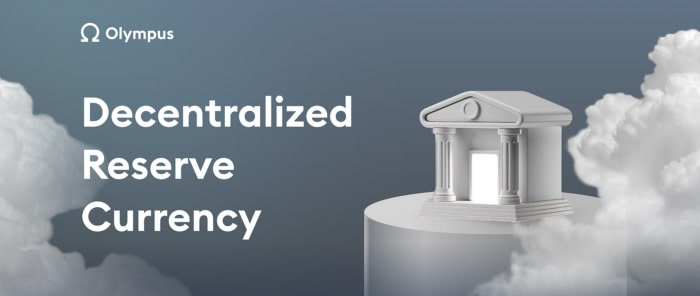Table of Contents
The real meaning of DeFi 2.0 is evolving, but a key element of this future DeFi generation is to incorporate alternatives to the pillars of DeFi 1.0, liquidity mining.
The term DeFi is a combination of the two words “decentralized” and “finance”. Basically, DeFi is a mechanism that makes financial items available on a decentralized, publicly accessible blockchain network. As a result, anyone can access and use DeFi instead of going through an intermediary such as a brokerage firm or bank. It also makes access even easier because you don’t need a formal ID card.

Although the real meaning of DeFi 2.0 is evolving, a key element of this future DeFi generation is to incorporate liquidity extraction, which is an alternative to what was previously defined as a pillar of DeFi 1.0.
Leading the wave of DeFi 2.0, Olympus DAO is a project that seeks new and innovative ways to bring users together to build a user base while at the same time finding ways to keep them on the platform.
What is Olympus DAO?
Olympus, which uses OHM as a native token, is a Decentralized Autonomous Organization (DAO). To avoid price declines, OHM is backed by a combination of crypto assets within the Olympus Treasury, including FRAX and DAI.

OHM holders have the authority to vote on the future roads of the Olympus DAO system and build a collaborative, community-based financial platform to ensure transparency and stability.
Olympus wants to be a global trading entity and at some point in the future a means of exchanging currencies in the real world.
How Do Users Earn with Olympus DAO?
Olympus DAO users can choose from two basic techniques for generating profits. Both methods are connected to the OHM token, which allows their use further extended.
Staking
Staking is a long-term approach where users are rewarded to add a certain amount of OHM tokens on the Olympus platform. Staking rewards are distributed depending on the amount you stake on the OHM blockchain.
In addition, users will be provided with sOHM that can be leveraged with various DeFi protocols.
To get OHM tokens from sOHM, the user must burn the sOHM tokens.
Bonding
Bond sales offer OHM as a reward. Bonding is a short-term profit approach that allows Olympus to own the reserves and liquidity entrusted to it.
Bonders offer LP tokens (Liquidity Provider Tokens) or their crypto assets (LUSD, DAI, wETH, FRAX, etc.) to get discounted OHM tokens. Bonds Sales have benefits from Olympus Traditional Ministry, which can collect its own liquidity.
The Olympus system offers that user Dai Bond, Weth Bond, Frax Bond, Ohmfrax LP Bond, and Ohmdai LP. Users can strategically select bonds based on ROI (investment rate). The only other way to earn ohms to earn directly through embroidery and restraint, buy it to buy it.
Users can purchase ohms with Defi Exchange such as Gate.io, Uniswap, and Sushiswap.
Disadvantages of DeFi 1.0
DeFi 1.0 was based on liquidity extraction. Simply put, liquidity mining is a mechanism by which the platform rewards users with their own native tokens in exchange for depositing resources for another user to trade or borrow.
The problem is that these protocols dilute the supply of tokens, usually in exchange for capricious capital contributions. That is, an individual comes in, commit the resource into the protocol, uses it to withdraw both resources and rewards, and dumps native tokens to the market.

There are many examples of this mystery. According to EGG Protocol, one such case is an initiative called the Big Data Protocol, which is worth about $ 6 billion in total. However, liquidity mining operations are not always short-lived. Compound Finance (COMP) Coin has operated long-term and continuous liquidity mining.
Anyway, despite its length, liquidity mining is a dangerous strategy for DeFi. As the Big Data Protocol Initiative shows, it reduces project bids and drains money from mercenaries.
Why is Olympus Introducing DAO DeFi 2.0?
Many new projects have abandoned liquidity mining (widely used in DeFi 1.0) and are supporting the search for new alternatives.
Olympus DAO has introduced DeFi 2.0 to overcome the shortcomings of DeFi 1.0. The staking and bonding mechanism allows Olympus to possess its own liquidity.
This is a significant difference from many (but not all) DeFi 1.0 projects where liquidity decreases as rewards are distributed to farmers.
According to Olympus DAO statistics on their website, the protocol owns over 99% liquidity of OHM-DAI bonds. The platform is owned by Olympus itself, so I’m pretty sure it won’t lose liquidity. Besides, they even get an LP fee!
Olympus DAO Fork
A fork refers to an optimized version of the code base for a particular project. Given the success of Olympus DAO’s unique fluidity model and the subsequent catalysis of the DeFi 2.0 movement, it’s no wonder that the Olympus DAO forks have arrived.
The most popular Olympus DAO forks are now Wonderland, Hunny DAO and Klima DAO.
Wonderland
Wonderland (TIME) is the first decentralized reserve currency protocol that allows users to earn compound interest through staking. According to their website, Wonderland’s APY is around 78,442.3% as of December 6, 2021.
Hunny DAO
Hunny DAO (LOVE) is a fork of Hunny Finance’s Olympus DAO, which promises long-term rarity and price consistency. According to their website, Hunny DAO’s APY is almost 3,727,368.7% on December 6, 2021.
Klima DAO
Klima DAO (KLIMA) aims to accelerate price inflation of carbon commodities and encourage companies and governments to quickly adapt to the reality of global warming and thereby invent technologies that reduce carbon emissions.
There are also some upcoming forks from OHM that include, but are not limited to, Venom DAO, TaiChi DAO, Snowbank, Spartan, Temple DAO, OtterClam, Exodia, etc.
Final Thoughts
DeFi 2.0 believes to be the solution for the DeFi 1.0 flaws. Both have the same goal, but their protocols are very important in terms of lifespan. Anyway, decentralized finance is definitely a good concept, especially for consumers, but it’s only time to know for sure if DeFi 2.0 will continue to rise.
Disclaimer: The opinion expressed here is not investment advice – it is provided for informational purposes only. It does not necessarily reflect the opinion of EGG Finance. Every investment and all trading involves risk, so you should always perform your own research prior to making decisions. We do not recommend investing money you cannot afford to lose.
 English
English Français
Français Español
Español Bahasa Indonesia
Bahasa Indonesia 中文 (中国)
中文 (中国) Русский
Русский Português
Português Deutsch
Deutsch

